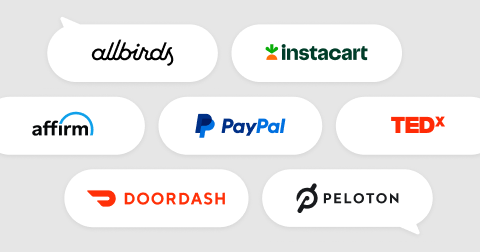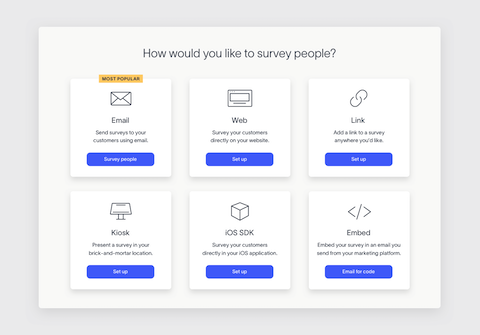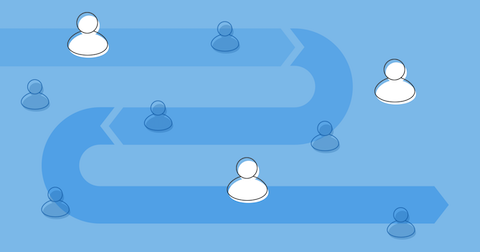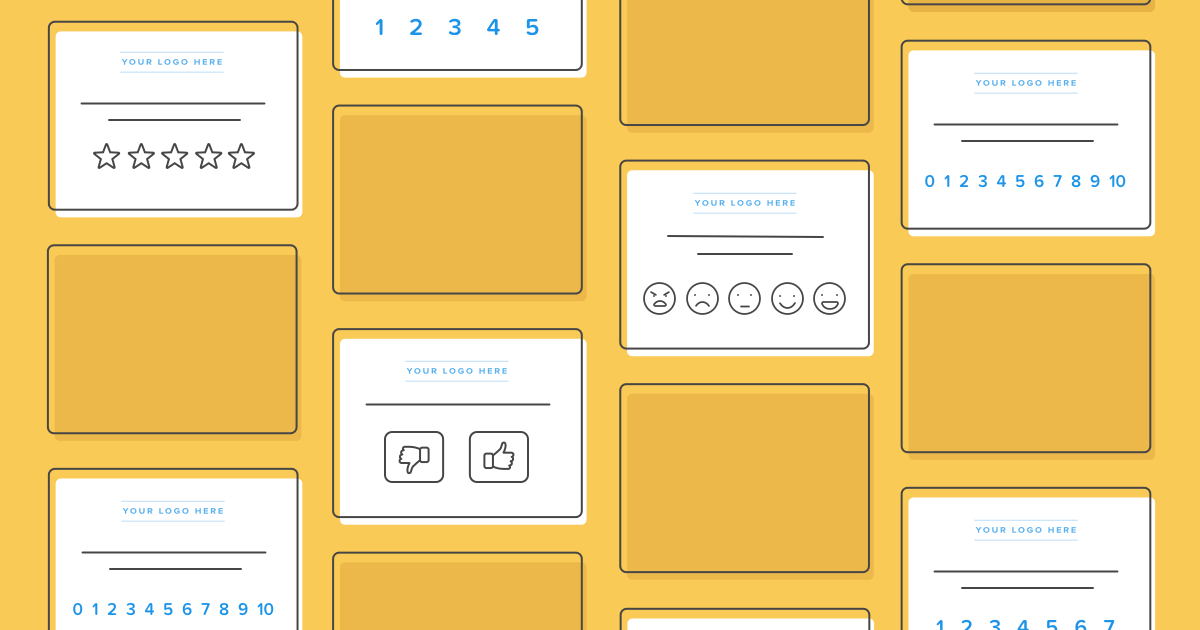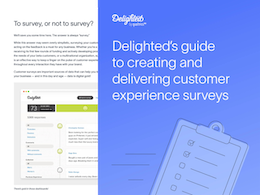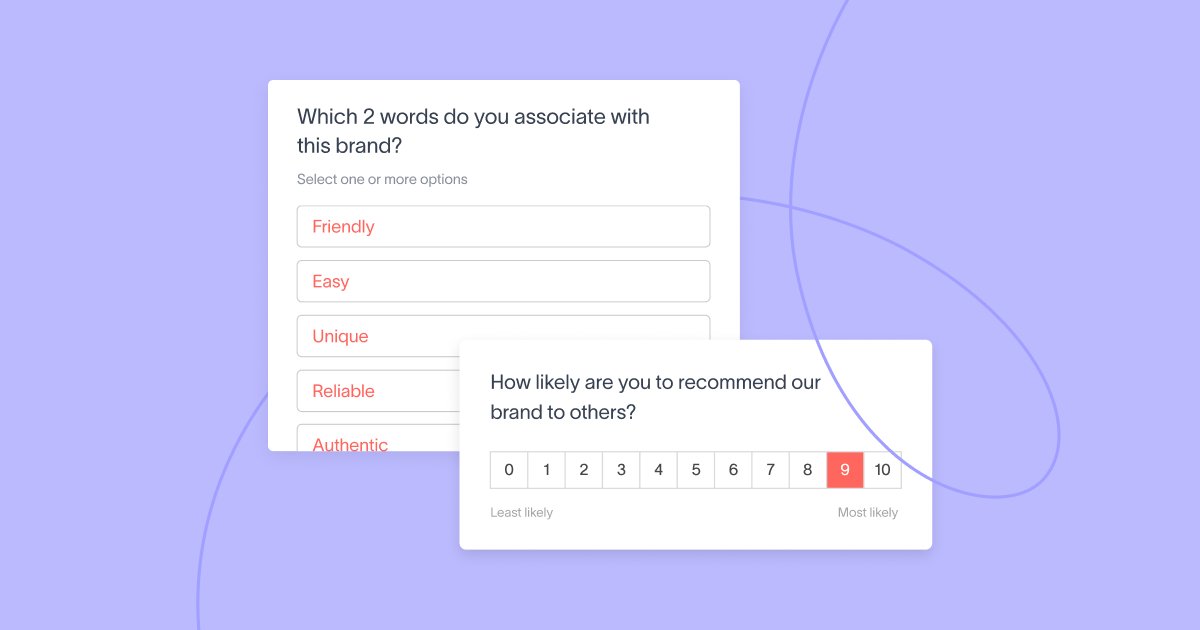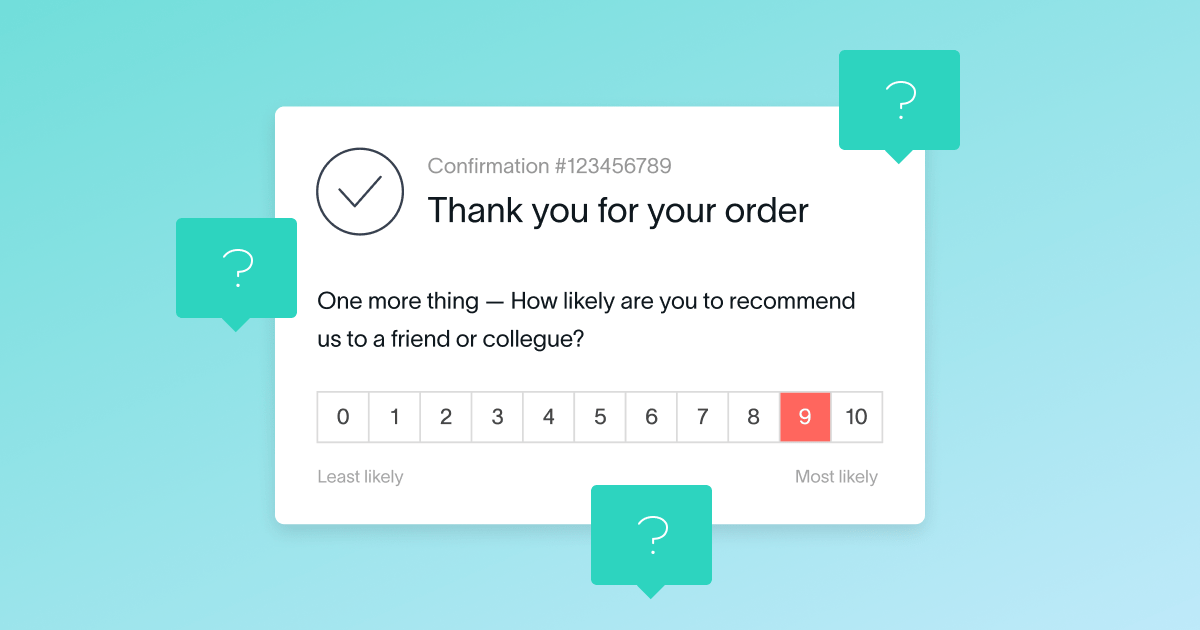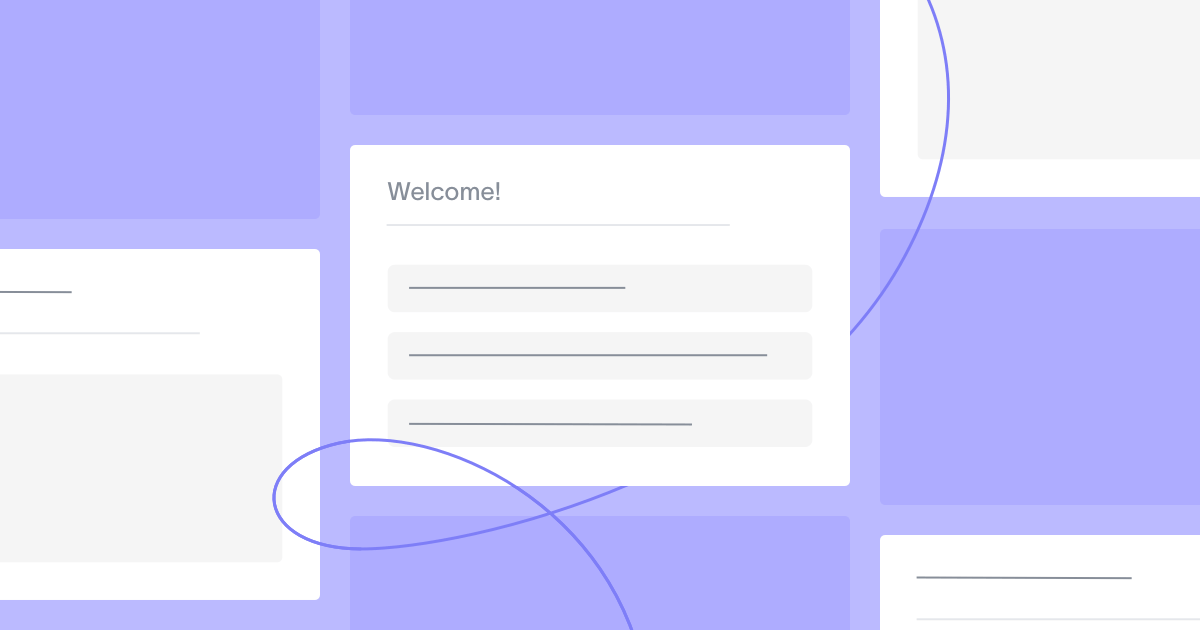You’ve decided to send surveys to your customers, collect feedback, and use those insights to improve your business. But knowing what you want feedback on is only part of the battle. Survey success also depends on choosing the right types of survey questions to get the insights you need.
In this post, we’ll break down the 8 types of survey questions and response options, the pros and cons of each, as well as our tips for writing good survey questions.
Types of survey questions
- Close-ended questions
- Multiple choice questions
- Rating scale questions
- Dichotomous questions
- Visual scale questions
- NPS survey questions
- Demographic questions
- Open-ended questions
Close-ended questions
Close-ended questions, or closed-ended questions, are a quantitative data collection method that require customers to choose from a list of answer options. Those answers can then be tallied into scores, percentages, or statistics that are tracked over time.
With close-ended survey questions, respondents are less likely to overthink their answers because they are given fewer options. Data from close-ended questions is also easier to collect and compare.
Close-ended questions work best when you have a good grasp of the exact topics you want feedback on and would like data that can be easily segmented for ongoing reports.
Multiple choice questions
Multiple choice questions might bring you back to grade school standardized testing – those timed tests that left you sweating while you frantically filled in the bubbles. In the context of a customer survey, these questions are much simpler for your customers to answer – that is, if you’ve provided a thoughtful, comprehensive set of responses.
To make things easier on your customers, you can also give them the option to select one or more options. Multiple choice questions are a great way to gather extra information to help you make new product decisions, understand where you can improve, or decide where to advertise to reach your audience.
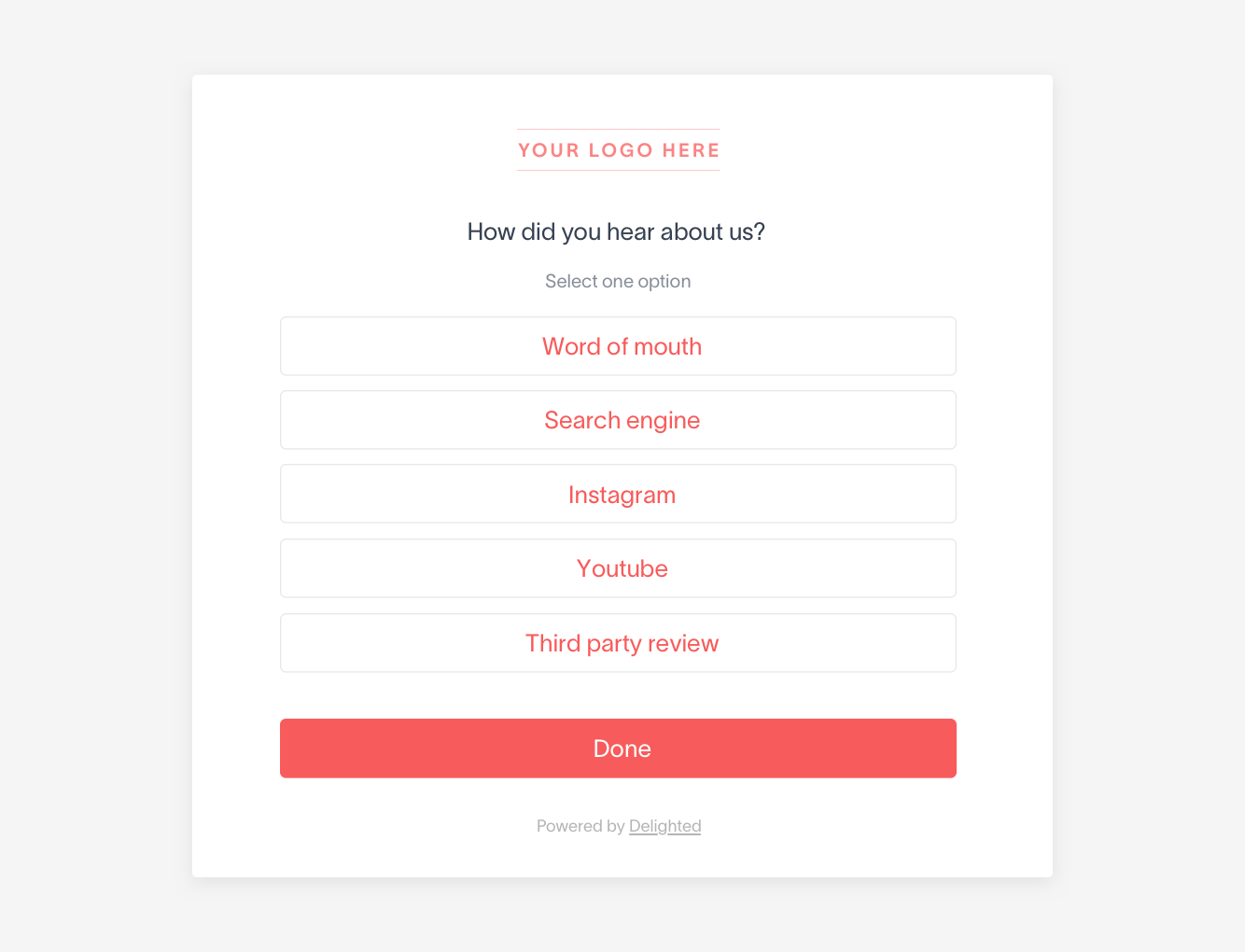
Multiple choice question pros
- Customers can choose one or multiple answers
- Results can be compiled and analyzed easily for insight
- Removes subjectivity from the answers
Multiple choice question cons
- Limits answers to the ones you’ve provided
- Leaves out the reason why
- Can be time-consuming to create
Multiple choice question tips
- Should consist of at least three different options
- Include an “other” response option in case none of the choices fit
- Answer options should be mutually exclusive
- Answers should all be plausible and simply phrased
Multiple choice question examples
- How can we do better? Answers could be options for new or improved product features or service offerings
- How did you hear about us? Answers could include social media, TV, newspaper, magazine, [Company] website, or word-of-mouth
Rating scale questions
A rating scale is one of the most well-known survey options. It allows folks to indicate what they think about a statement or attitude on a 5 or 7-point scale. You can set up rating scales with either a bipolar or unipolar construct.
Bipolar means the scale runs from negative to positive, with a neutral rating in the middle. For example, a bipolar scale could go from “strongly disagree” to “strongly agree,” with “neither disagree nor agree” in the center of the scale.
A unipolar scale ranges from zero to positive, and is used when a negative rating wouldn’t make sense semantically. For instance, the star rating question, “How would you rate your experience” wouldn’t have an option for negative stars, and would be a unipolar scale. A question rated along the lines of “effectiveness” would also be unipolar, since it’s impossible for something to be “negative effective.” It can only be “ineffective.”
Rating scale question pros
- Flexibility in creating the rating scale
- Can be used to evaluate any part of the customer experience
- Provides a statistic that is easily tracked over time
Rating scale question cons
- Doesn’t dig into why customers choose a specific rating
- Requires some preparation to determine which facets of the business are most important to ask about
Rating scale question tips
- Use a balanced scale with equal positive and negative responses
- Include a neutral response for those without strong feelings either way
- Use this scale to find out what customers think or feel about products, services, websites, advertising, or other aspects of your business
Rating scale question examples
The Customer Effort Score (CES) survey is a great example of a rating scale survey. Customers respond on a scale of 1 to 5 on how strongly they agree with the statement, with 5 indicating “strongly agree”. This type of disagree-agree scale is also known as a Likert scale.
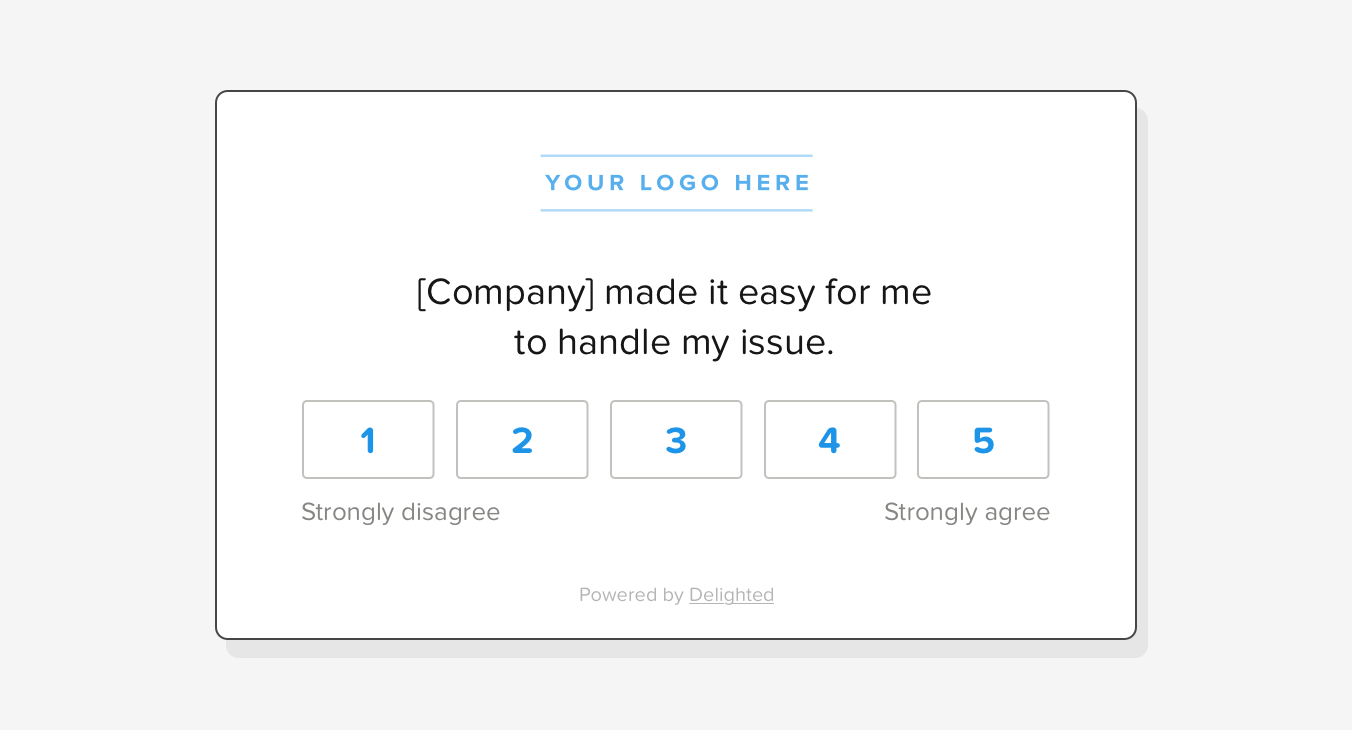
[Company website] made it easy for me to handle my issue. The answers here would be:
- 1: Strongly disagree
- 2: Slightly disagree
- 3: Neutral
- 4: Slightly agree
- 5: Strongly agree
Customer Satisfaction Score (CSAT) surveys are another example of a rating scale survey.

How satisfied were you with [Company/aspect of the customer experience]? The answers here would be:
- 1: Very dissatisfied
- 2: Slightly dissatisfied
- 3: Neutral
- 4: Satisfied
- 5: Very satisfied
CES surveys measure how easy it is for customers to accomplish their goal, while CSAT surveys measure satisfaction. Both questions can be modified to evaluate customer sentiment about specific customer touchpoints.
For example, you could create custom follow-up questions after a customer support CSAT survey to ask for ratings on staff product knowledge, helpfulness, courteousness, and problem resolution. For more ideas on what to ask, here’s a full list of customer satisfaction survey question examples.
Dichotomous questions
A dichotomous survey is a question with only two possible answers: yes/no, true/false, or agree/disagree. Designed for fast, easy responses, dichotomous survey questions enable straightforward evaluations. They also work well as screening questions.
For example, you could ask your customers whether they’re aware of a certain product feature, and then dive deeper with a different set of questions depending on how they answer. In survey design, this is called conditional logic – only asking specific, additional questions if they apply.
Dichotomous question pros
- Simple and quick to answer
- Results are easy to understand at a glance
- Allows you to divide customers into two different groups
Dichotomous question cons
- Doesn’t allow for higher sensitivity
- Forces a yes/no answer when more information may be needed
- Doesn’t have a neutral option for those who don’t feel strongly one way or the other
Dichotomous question tip
- Always phrase the question for a yes/no answer
Dichotomous question examples
- How was your experience with [Company]?
- Was your customer support issue resolved?
- Have you purchased/used [Company’s] product or service in the last 30 days?
- Have you ever used [Company] website to purchase a product or service?
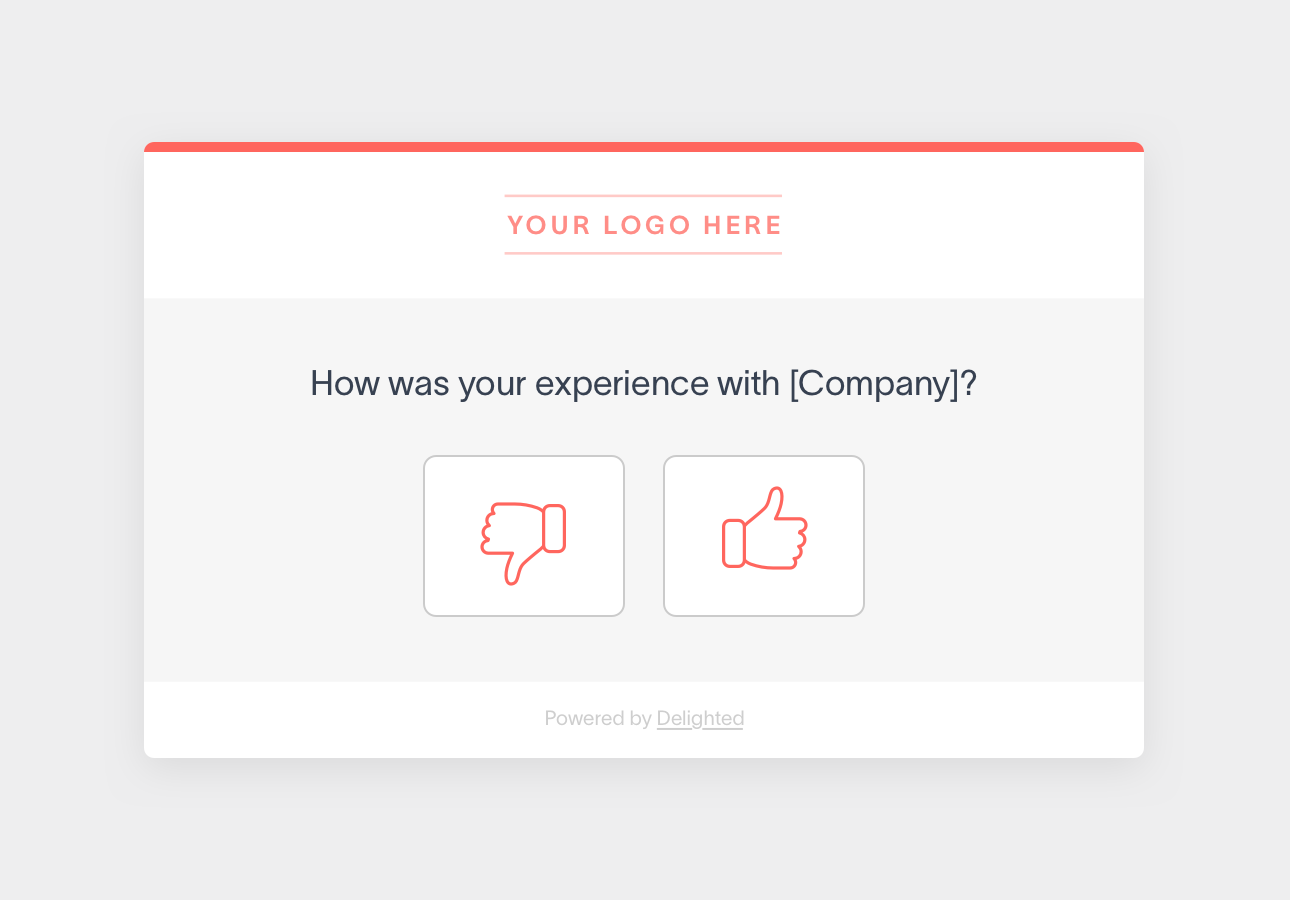
Thumbs surveys include a dichotomous survey question. Instead of selecting yes or no, however, customers choose a thumbs up or thumbs down. When used as the initial question, it is always followed by an open-ended question so customers can provide an explanation behind their answer.
Visual scale questions
Visual scale surveys make it easy for respondents to select a rating because they elicit an intuitive response.
The smiley scale is well known in hospital rooms under the “rate your pain” question, with the crying face signifying intense pain and the smiley face signifying the least amount of pain. It is easier for someone to select an option when they can place an emotion behind it.
Visual scale question pros
- Easy to react to
- Visually appealing
- Transcends language barriers
- Increases responses and engagement
Visual scale question con
- Can only be used for satisfaction-style questions
Visual scale question tips
- Do not explain the scale, which counters the intuitive nature of the scale
- Be sure that the question is phrased in a way that fits the context of a smiley face scale
Visual scale question example
How happy are you with the [Company’s] product or service?
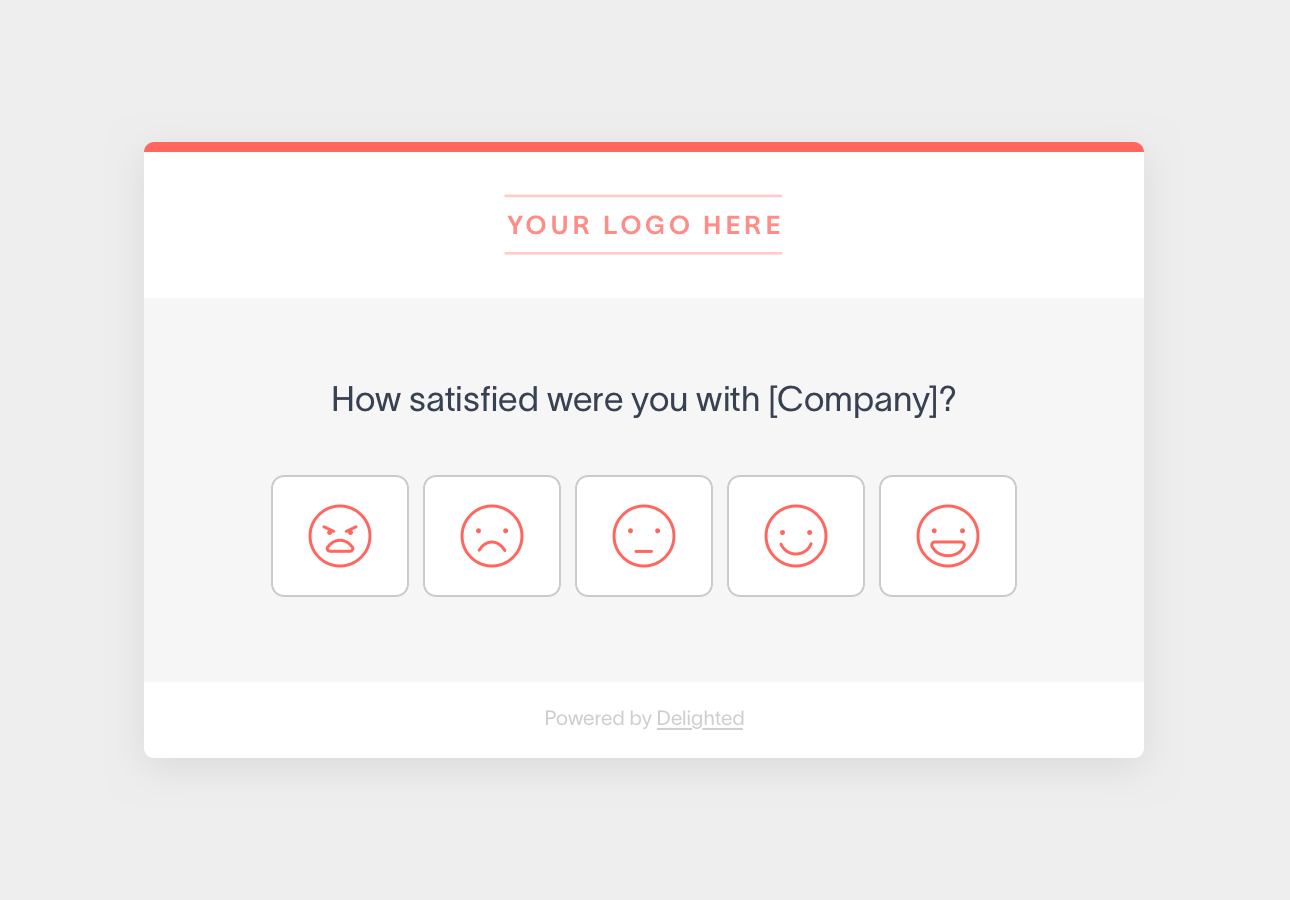
Smiley face surveys are a fun and engaging way to gather product and customer support feedback. Follow up with an open-ended question for more details.
Net Promoter Score (NPS) survey questions
Net Promoter Score (NPS) surveys not only measure customer satisfaction, but also indicate brand loyalty. The NPS question assesses the likelihood that someone will recommend your company to friends or family.
Even though the question includes a 0 to 10 scale, we set it apart from a traditional rating scale survey because of how the responses are scored.
Responses are sorted into detractors, passives, and promoters. Detractors are those who rate you 0 to 6, and are the least satisfied with your business. Passives are in between with a 7 or 8 score. Promoters give you the highest score with a 9 or 10 and are your most loyal customers.
To find your NPS score, manually subtract the percentage of detractors from the percentage of promoters. Or, you can calculate your score automatically using an NPS calculator. Then, track your score over time using an NPS tool.
NPS question pros
- Simple way to assess brand loyalty
- Valuable insights into promoters and detractors
- Can be used for relationship and transactional surveys
NPS question cons
- More complex to analyze than standard satisfaction surveys
- When used to measure the entire customer experience, it can be difficult to pinpoint areas for improvement
NPS question tips
- Use this survey to understand your customers’ relationship with your brand
- Send relationship surveys at regular intervals, such as yearly, bi-yearly, or quarterly
- Don’t let the score be the only metric by which you evaluate customer loyalty — layer in other customer experience metrics such as lifetime value and usage frequency for a complete picture
NPS question example
The classic NPS question is: “On a scale of 0-10, how likely are you to recommend [Company] to family and friends?” Follow up with an open-ended question asking why they chose a specific number. You can also modify the NPS survey question to ask about a specific product or support interaction.
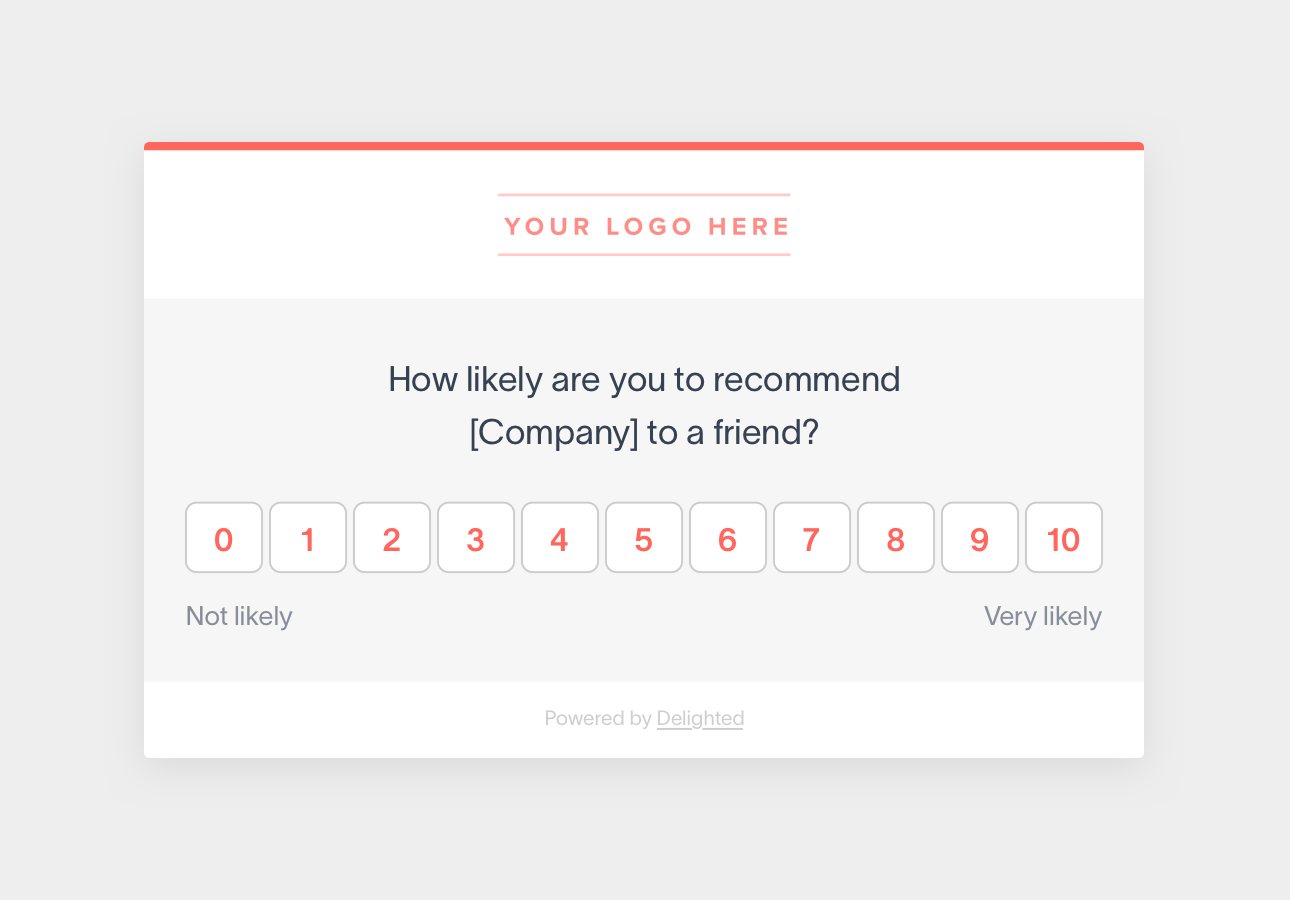
Delighted has a templated NPS survey that you can easily customize to suit your needs.
Demographic questions
Demographic survey questions are multiple choice questions that appear at the end of almost every questionnaire. These questions help you understand who your customers are and where they come from. They ask questions about location, age, income, gender, race, or lifestyle.
Demographic question pros
- Tell you about your customers so you know how to market to them
- Help you target a specific audience or group
Demographic question con
- Some respondents may not feel comfortable answering personal questions
Demographic question tips
- Avoid asking what you already know about your customers
- Only ask for information that impacts your business strategy
Demographic question examples
- How old are you? Provide mutually exclusive options such as under 18, 18-24, 25-34, 35-44, 45-54, 55-64, 65+ years old
- What is your annual household income? Provide multiple options such as $0-$29,000, $30,000-$59,999, $60,000-$89,999, $90,000-$119,999, $120,000+
- How many employees does your company have? Multiple choice options can include 1-10, 11-25, 26-50, 51-80, 81-120, 121-250, 251+
- Other questions can include ethnicity, marital status, education, industry type, business locations, etc.
Open-ended questions
Open-ended questions are a qualitative data collection method that allows respondents to answer in their own words. Of the different types of survey questions, the open-ended format encourages respondents to add supplemental details. These questions prompt customers to share their opinions in greater detail, resulting in them feeling more heard and valued during the feedback process.
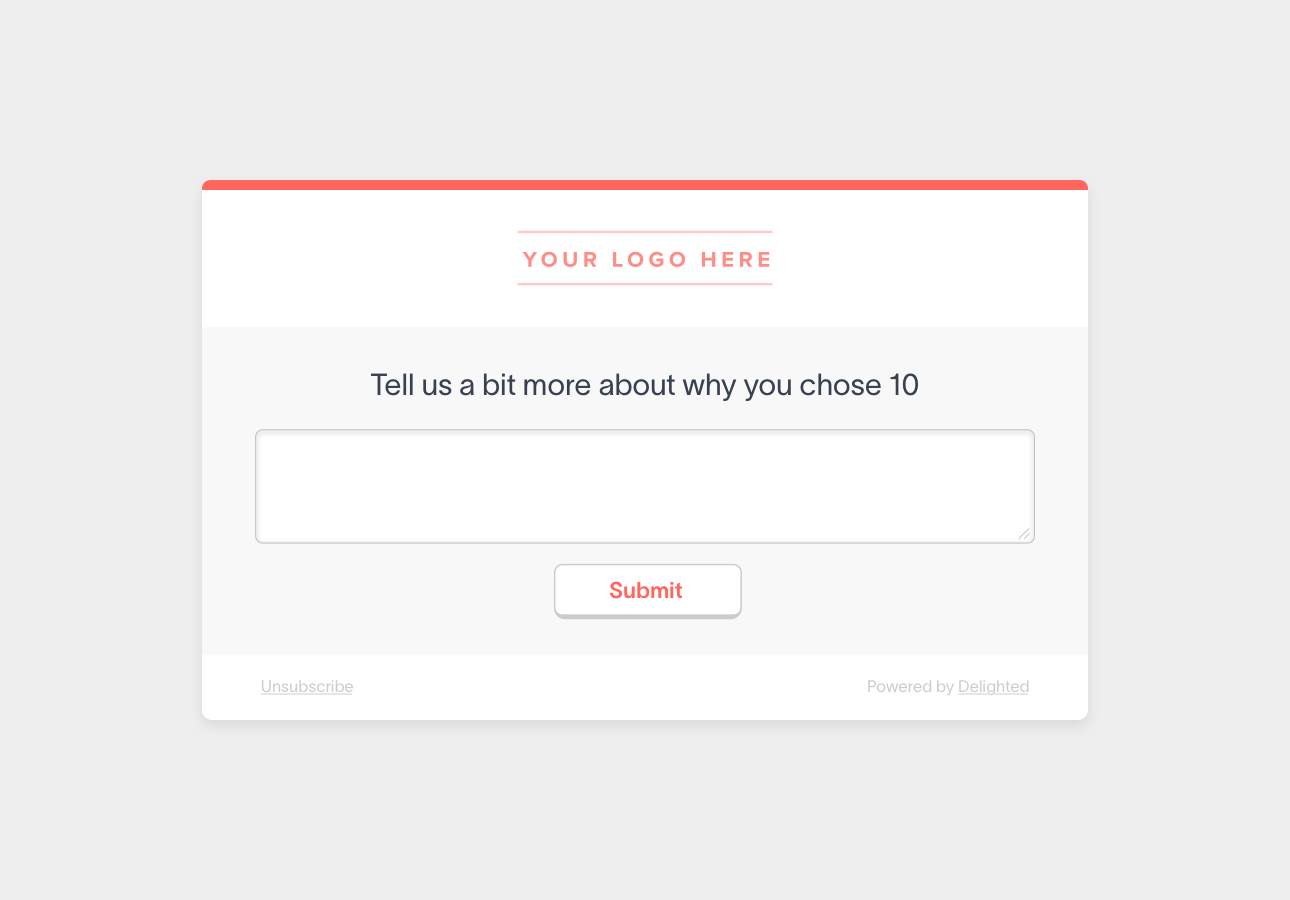
These questions require more critical thinking and provide insights into your company that you may not have been aware of. They’re perfect for following up on answers to quantitative close-ended questions to get more context.
TIP: Learn more about qualitative vs. quantitative research in our guide.
Open-ended question pros
- Help you understand the why behind their sentiment
- Provide qualitative data
- Capture simple customer information, such as email or product purchased, for surveys that are distributed in a more anonymous manner (e.g. kiosk or web)
Open-ended question cons
- Time-consuming to answer and analyze
- Less engagement
Open-ended question tip
- Use open-ended questions to invite customers to explain their rating after a close-ended question, so you can tie that open-ended feedback to a score
Remember that open-ended questions provide valuable insight into your customers’ thoughts, but not statistical or categorical data.
Open-ended question examples
There are plenty of ways to ask open-ended survey questions. For example: “Tell me more about why you chose [rating/option]” is the classic open-ended question for following up on a close-ended question. Asking “How can we improve?” or “Is there anything else you would like us to know?” at the very end of a survey can also capture any feedback your previous questions didn’t surface.
Tips for writing good survey questions
Now that we’ve covered survey question types, let’s review some tips and best practices for crafting great questions and designing effective surveys.
1. Use clear language and avoid jargon
When crafting your survey questions, be sure to use language that’s easily understood by your target audience. If survey questions contain confusing terminology, acronyms, or technical jargon, survey respondents may become confused or frustrated, or worse, drop out of the survey altogether.
Our advice? Keep your survey questions as straightforward as possible. That way, respondents are more likely to understand what is being asked of them and provide accurate, honest answers. This will lead to more insightful data and a better understanding of your audience.
2. Avoid leading questions
Of course, you want insights you can take action on, but asking leading questions – that is, questions that encourage or guide the respondent toward a desired answer – can do more harm than good.
Asking leading questions has the potential to not only return unhelpful responses, but also produce misleading or biased results – results that, should you take action on them, could lead to some unintended (and unwanted) business outcomes.
3. Avoid asking two questions in one
Like leading questions, double-barreled questions can confuse respondents and hinder your survey results. This type of survey question asks two questions in one, making it impossible to know which question the respondent’s answer applies to.
Thankfully, double-barreled questions are easy to identify because they typically include words like “and” or “or” to connect the series of questions. Be sure to always proofread and weed out these types of questions from your surveys.
4. Keep your questions – and survey – short and to the point
The shorter your survey is, the more likely respondents are to complete it. Not only do shorter surveys boost your survey completion rate, but they also increase your survey response rate in general. To set expectations ahead of time, let your respondents know how long the survey will take to complete in a survey introduction message.
5. Focus on effective survey design
How you design and use different types of surveys matters just as much as the questions you ask. When creating your survey, follow these design best practices to ensure the survey is as effective as possible in reaching your research goals.
Here are some common best practices to follow:
- Define clear goals for your survey
- Distribute surveys through the best channel for your business
- Use skip logic so customers can skip questions they don’t want to answer
- Enable conditional logic so customers are shown questions based on previous responses
Ready to get started? Try out all types of survey questions and collect actionable feedback with Delighted’s free survey tools.
